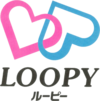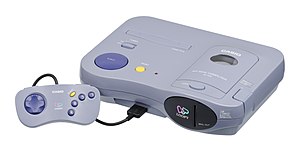Infrastructure tools to support an effective radiation oncology learning health system
Contents
 | |
 | |
| Also known as | My Seal Computer SV-100 |
|---|---|
| Manufacturer | Casio |
| Type | Home video game console |
| Generation | Fifth |
| Lifespan |
|
| Introductory price | 25,000¥ |
| Media | ROM cartridge |
| CPU | SH7021 32-bit SuperH |
| Memory | 1MB RAM |
| Storage | 2MB ROM |
| Display | NTSC-M composite video out |
| Graphics | 512 colors |
| Sound | 4 channels, 12-bit PCM |
| Controller input | D-pad and mouse |
| Predecessor | PV-1000 |


The Casio Loopy (Japanese: ルーピー, Hepburn: Rūpī), subtitled My Seal Computer SV-100, is a 32-bit home video game console. Released exclusively in Japan in October 1995 with a price of 25,000¥, the marketing for it was completely targeted to female gamers.[1][2][3]
The console is powered by a Hitachi SH7021 SuperH 32-bit RISC CPU running at 16MHz, and had 1MB of RAM and 2MB of ROM.[4][5] It was capable of displaying 512-color graphics and of playing 4 channels of 12-bit PCM audio.[5]
The Loopy has one controller port[1] for use with a standard game controller or with a mouse which was sold separately.
The Loopy includes a built-in thermal color printer that could be used to create stickers from game screenshots. An optional accessory, called Magical Shop (マジカルショップ, Majikaru Shoppu),[5] was a video capture device to obtain images from VCRs and DVD players. Users may add text to these images and make stickers. Including Magical Shop's own built-in software, the Loopy library contained 11 titles.[5]
Developer Kenji Terada worked on I Want a Room in Loopy Town! (ルーピータウンのおへやがほしい!, Rūpī Taun no O-heya ga Hoshii!).[6]
Software development ended in November 1996, and Casio ceased production of the console in December 1998.[1]
Games
Eleven titles were released for the system.[5][7][2]
- Anime Land (あにめらんど, Animerando)
- Bow-wow Puppy Love Story (わんわん愛情物語, Wanwan Aijō Monogatari)
- Dream Change: Kokin-chan's Fashion Party (ドリームチェンジ 小金ちゃんのファッションパーティー, Dorīmuchenji Kokinchanno Fasshonpātī)
- HARIHARI Seal Paradise (HARIHARIシールパラダイス, HARIHARI Shīru Paradaisu)
- I Want a Room in Loopy Town! (ルーピータウンのおへやがほしい!, Rūpī Taun no O-heya ga Hoshii!)
- Little Romance (リトルロマンス, Ritoru Romansu)
- Lupiton's Wonder Palette (ルピトンのワンダーパレット, Rupiton no Wandāparetto)
- Chakra-kun's Charm Paradise (チャクラくんのおまじないパラダイス, Chakurakun no Omajinai Paradaisu)
- Caricature Artist (似顔絵アーティスト, Nigaoe Ātisuto)
- PC Collection (パソコン・コレクション, Pasokon Korekushon)
- Magical Shop (マジカルショップ, Majikaru Shoppu)
The games PC Collection and Lupiton's Wonder Palette were both packaged either as stand-alone or bundled with the mouse.
References
- ^ a b c Packwood, Lewis (2018-07-15). "In the Loopy: the story of Casio's crazy 90s console". Eurogamer.net. Retrieved 2023-03-26.
- ^ a b Branagan, Nicole (Dec 15, 2021). "Isn't she just Misunderstood? The Casio Loopy!". nicole.express. Retrieved 2023-03-26.
- ^ "Casio Loopy カシオルーピー". FEMICOM. Retrieved 2023-03-26.
- ^ "Casio Loopy". OLD-COMPUTERS.COM : The Museum. Retrieved 20 January 2021.
- ^ a b c d e Blanchard, Jonn (29 December 2017). "Casio Loopy". Re-enthused: world of retro. Retrieved 20 January 2021.
- ^ Weil, Rachel (December 4, 2013). "FEMICOM Kenji Terada, writer for early Final Fantasy games, worked on a little-known Animal Crossing-like game in the 1990". FEMICOM Museum. Retrieved 20 January 2021.
- ^ "Casio Loopy Collection". FEMICOM Museum. Retrieved 2023-03-26.

















